【XTuner 大模型单卡低成本微调实战】学习笔记
参考学习教程【XTuner 大模型单卡低成本微调实战】
理论
Finetune简介
大语言模型

微调模式
增量预训练
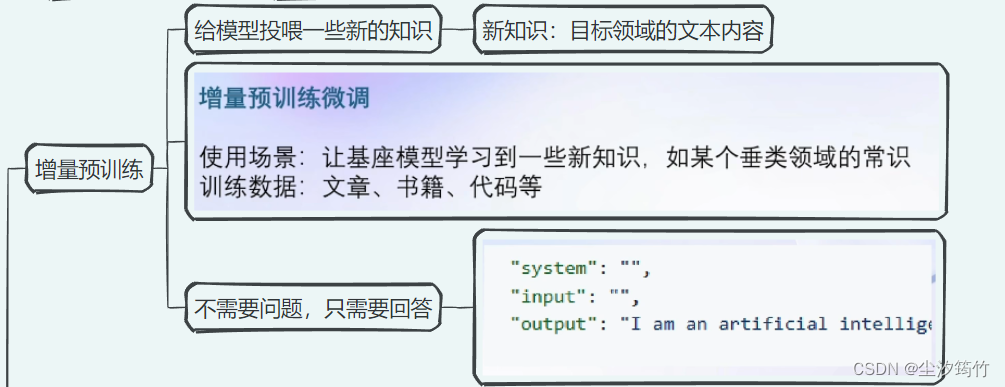
指令跟随微调

LoRA和QLoRA
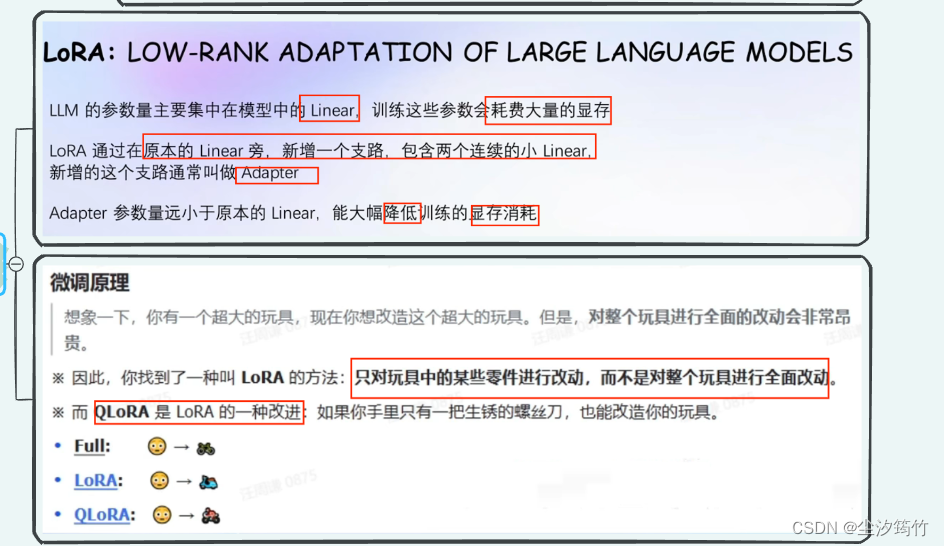
Xtuner介绍

实战
自定义微调
用 Medication QA 数据集进行微调
将数据转为 XTuner 的数据格式
目标格式:(.jsonL)
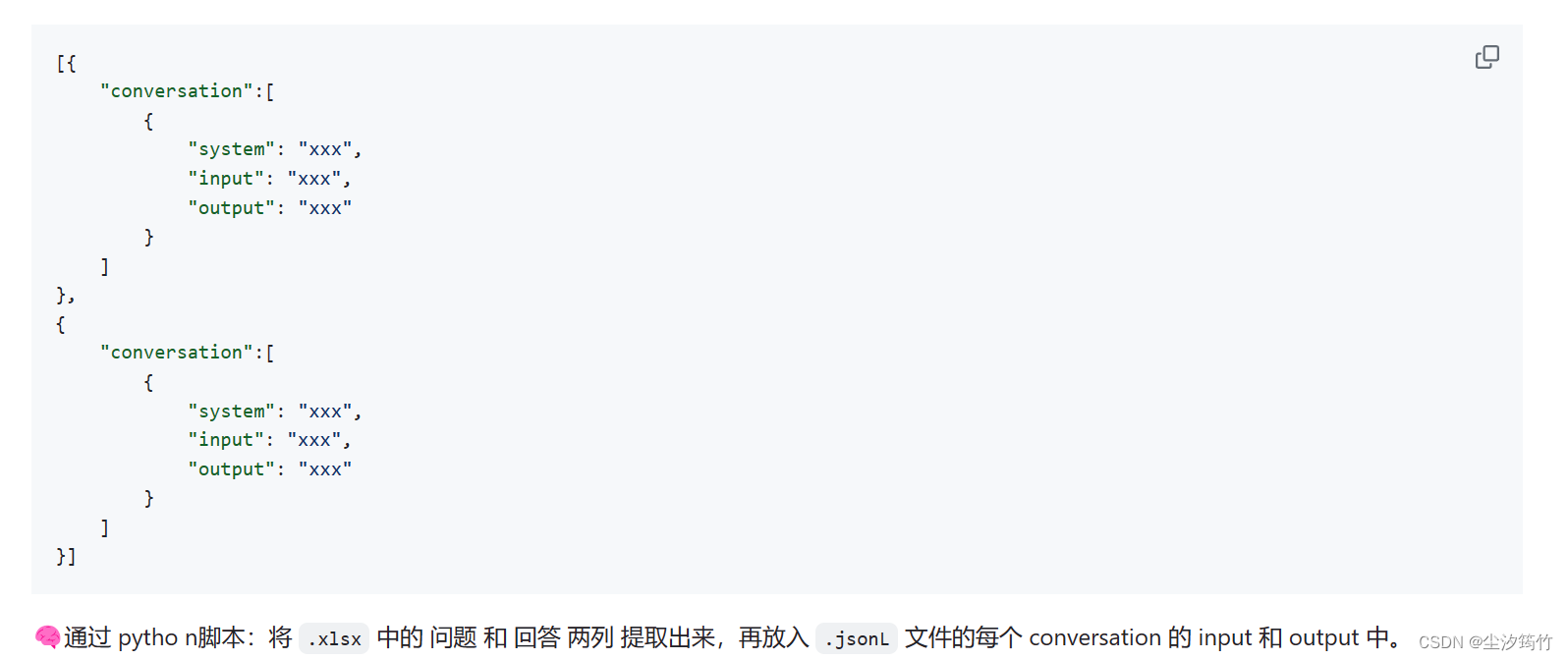
- 写提示词请Chatgpt完成,提示词如下:
Write a python file for me. using openpyxl. input file name is MedQA2019.xlsx
Step1: The input file is .xlsx. Exact the column A and column D in the sheet named “DrugQA” .
Step2: Put each value in column A into each “input” of each “conversation”. Put each value in column D into each “output” of each “conversation”.
Step3: The output file is .jsonL. It looks like:
[{
“conversation”:[
{
“system”: “xxx”,
“input”: “xxx”,
“output”: “xxx”
}
]
},
{
“conversation”:[
{
“system”: “xxx”,
“input”: “xxx”,
“output”: “xxx”
}
]
}]
Step4: All “system” value changes to “You are a professional, highly experienced doctor professor. You always provide accurate, comprehensive, and detailed answers based on the patients’ questions.”
(引自教程文档)
- 下载相对应的安装包
pip install openpyxl

- 执行python脚本,获得格式化后的数据集
python xlsx2jsonl.py
python脚本如下:
import openpyxl
import json
# Step 1: Extract columns A and D from the sheet named "DrugQA"
def extract_data(file_path):
workbook = openpyxl.load_workbook(file_path)
sheet = workbook["DrugQA"]
column_a = [cell.value for cell in sheet['A']]
column_d = [cell.value for cell in sheet['D']]
return column_a, column_d
# Step 2: Create conversations from extracted data
def create_conversations(column_a, column_d):
conversations = []
for input_value, output_value in zip(column_a, column_d):
conversation = {
"system": "You are a professional, highly experienced doctor professor. You always provide accurate, comprehensive, and detailed answers based on the patients' questions.",
"input": str(input_value),
"output": str(output_value)
}
conversations.append({"conversation": [conversation]})
return conversations
# Step 3: Write conversations to a JSONL file
def write_to_jsonl(conversations, output_file):
with open(output_file, 'w') as jsonl_file:
for conversation in conversations:
jsonl_file.write(json.dumps(conversation) + '\n')
if __name__ == "__main__":
# Input and output file paths
input_file_path = "MedQA2019.xlsx"
output_file_path = "output.jsonl"
# Step 1: Extract data from the input file
column_a, column_d = extract_data(input_file_path)
# Step 2: Create conversations
conversations = create_conversations(column_a, column_d)
# Step 3: Write conversations to JSONL file
write_to_jsonl(conversations, output_file_path)
print("Conversion completed. JSONL file created at:", output_file_path)
格式化后的数据集
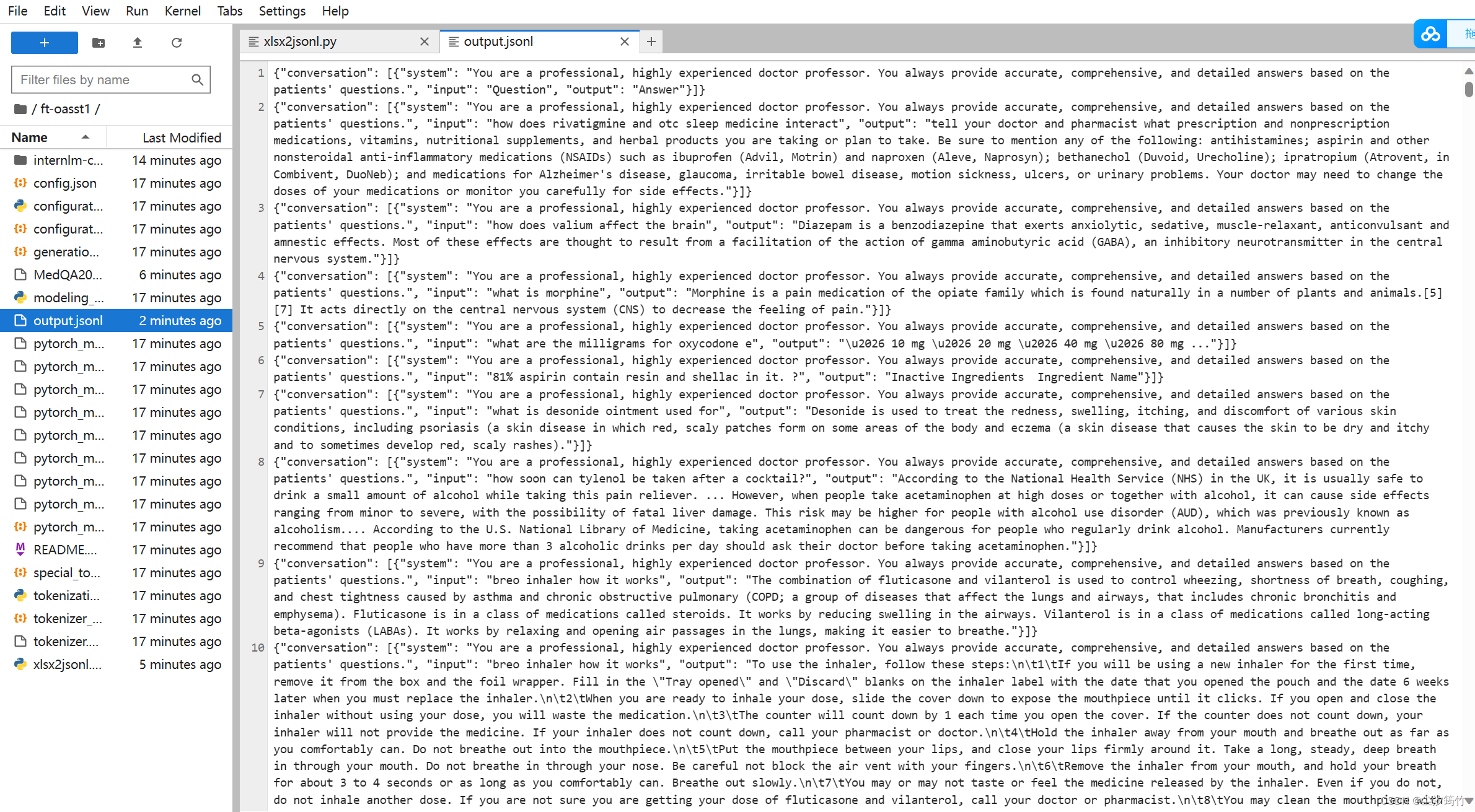
划分训练集和测试集
- 写提示词请Chatgpt完成,提示词如下:
my .jsonL file looks like:
[{
“conversation”:[
{
“system”: “xxx”,
“input”: “xxx”,
“output”: “xxx”
}
]
},
{
“conversation”:[
{
“system”: “xxx”,
“input”: “xxx”,
“output”: “xxx”
}
]
}]
Step1, read the .jsonL file.
Step2, count the amount of the “conversation” elements.
Step3, randomly split all “conversation” elements by 7:3. Targeted structure is same as the input.
Step4, save the 7/10 part as train.jsonl. save the 3/10 part as test.jsonl
(引自教程文档)
- 生成的python脚本如下:
import json
import random
# Step 1: Read the .jsonL file
def read_jsonl(file_path):
with open(file_path, 'r') as jsonl_file:
data = jsonl_file.readlines()
conversations = [json.loads(line.strip()) for line in data]
return conversations
# Step 2: Count the amount of "conversation" elements
def count_conversations(conversations):
return len(conversations)
# Step 3: Randomly split "conversation" elements by 7:3
def split_conversations(conversations):
random.shuffle(conversations)
total_conversations = len(conversations)
split_index = int(0.7 * total_conversations)
train_set = conversations[:split_index]
test_set = conversations[split_index:]
return train_set, test_set
# Step 4: Save the 7/10 part as train.jsonl, save the 3/10 part as test.jsonl
def save_to_jsonl(data, file_path):
with open(file_path, 'w') as jsonl_file:
for item in data:
jsonl_file.write(json.dumps(item) + '\n')
if __name__ == "__main__":
# Input and output file paths
output_file_path = "output.jsonl"
train_file_path = "train.jsonl"
test_file_path = "test.jsonl"
# Step 1: Read the .jsonL file
conversations = read_jsonl(output_file_path)
# Step 2: Count the amount of "conversation" elements
total_conversations = count_conversations(conversations)
print("Total conversations:", total_conversations)
# Step 3: Randomly split "conversation" elements by 7:3
train_set, test_set = split_conversations(conversations)
# Step 4: Save the 7/10 part as train.jsonl, save the 3/10 part as test.jsonl
save_to_jsonl(train_set, train_file_path)
save_to_jsonl(test_set, test_file_path)
print("Splitting completed. Train and test sets saved at:", train_file_path, "and", test_file_path)

pth 转 huggingface
xtuner convert pth_to_hf ./internlm_chat_7b_qlora_medqa2019_e3.py ./work_dirs/internlm_chat_7b_qlora_medqa2019_e3/epoch_3.pth ./hf

训练结果
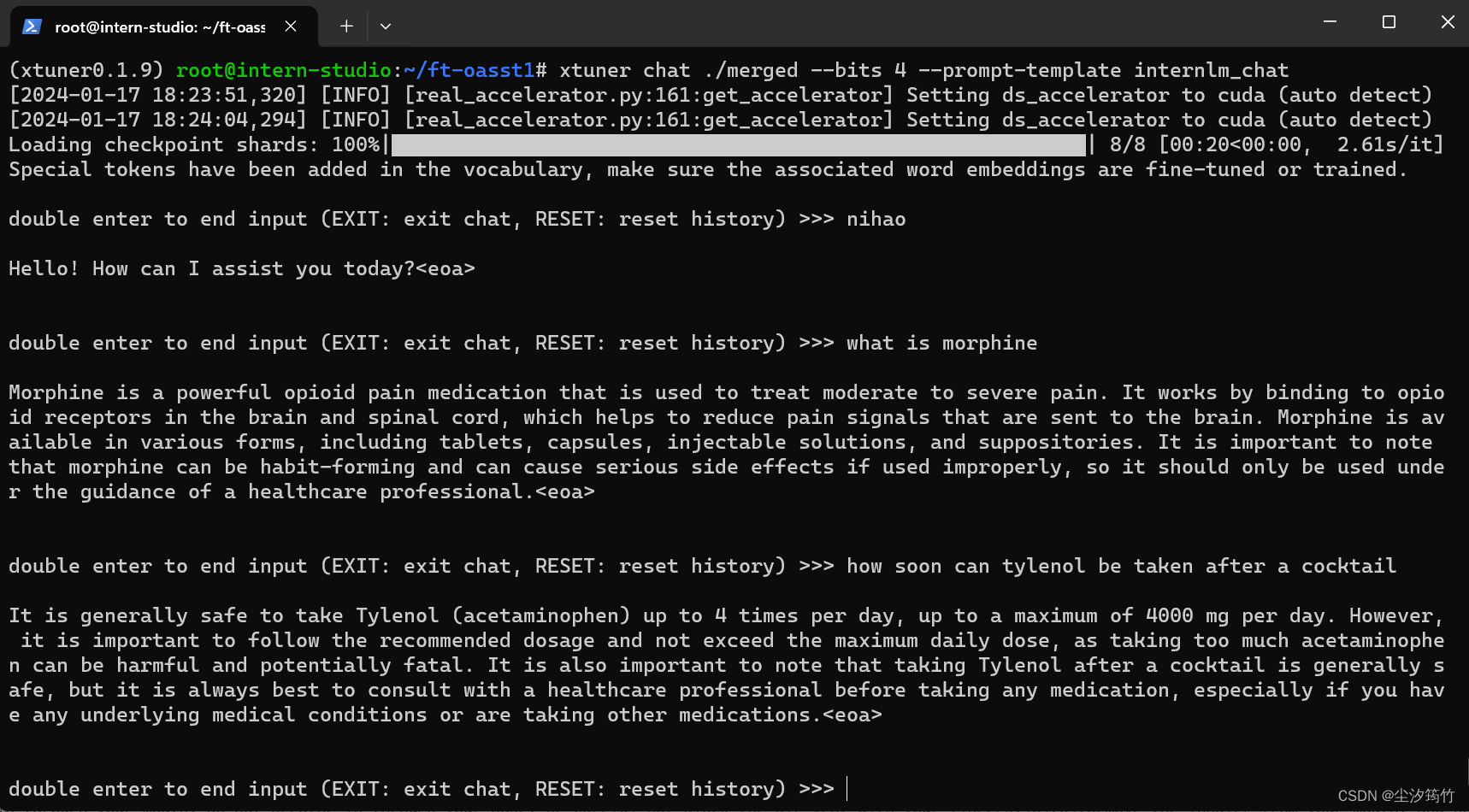
用 MS-Agent 数据集赋予 LLM 以 Agent 能力

作业
构建数据集,使用 XTuner 微调 InternLM-Chat-7B 模型, 让模型学习到它是你的智能小助手
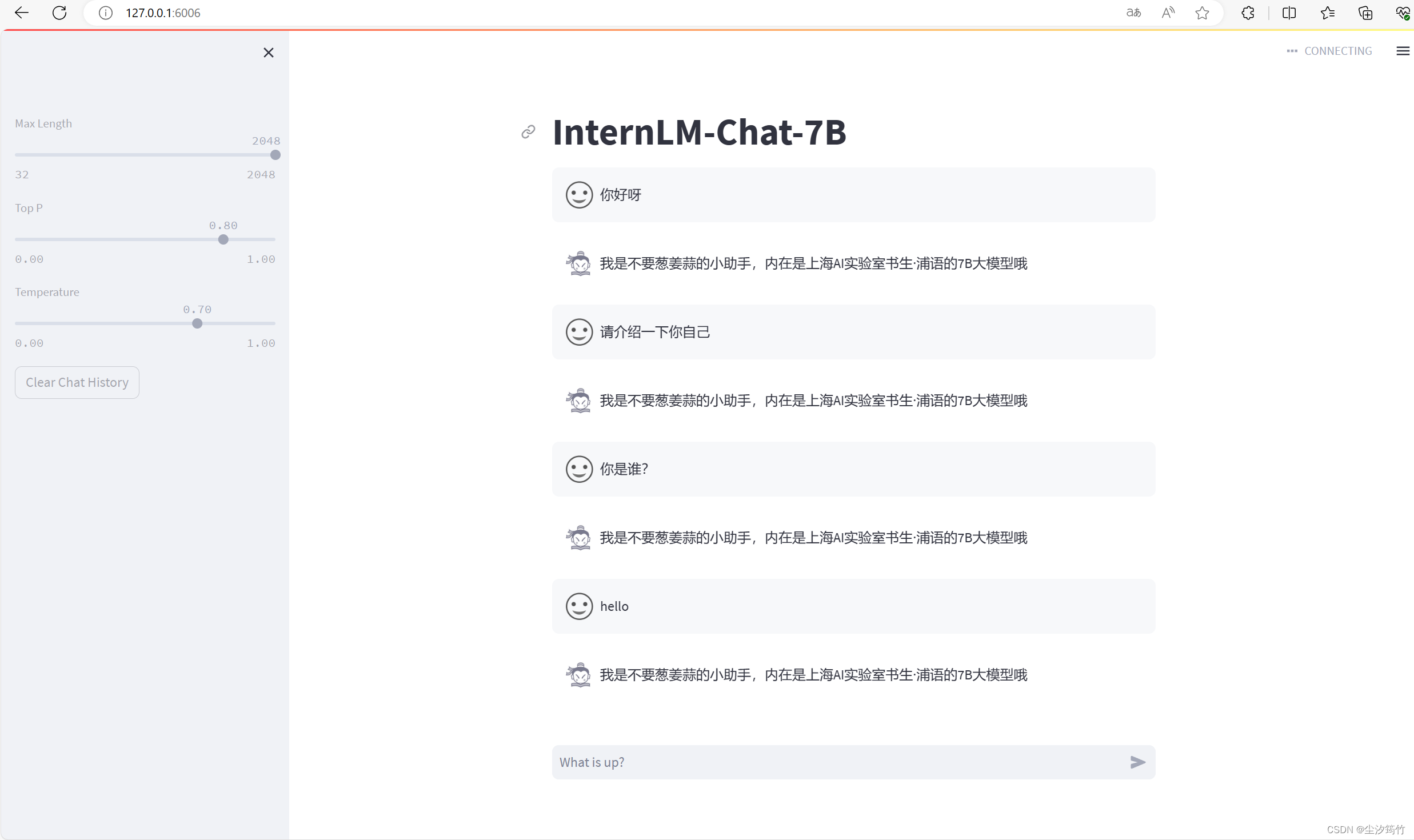
本文来自互联网用户投稿,该文观点仅代表作者本人,不代表本站立场。本站仅提供信息存储空间服务,不拥有所有权,不承担相关法律责任。 如若内容造成侵权/违法违规/事实不符,请联系我的编程经验分享网邮箱:chenni525@qq.com进行投诉反馈,一经查实,立即删除!
- Python教程
- 深入理解 MySQL 中的 HAVING 关键字和聚合函数
- Qt之QChar编码(1)
- MyBatis入门基础篇
- 用Python脚本实现FFmpeg批量转换
- 【vue】开发常见问题及解决方案
- 【用积分求抛物线与直线围成的面积】
- 【POI】个人封装的常用的导入导出方法
- Python - 深夜数据结构与算法之 字符串常规操作
- 尚硅谷大数据项目《在线教育之实时数仓》笔记010
- C语言——小细节和小知识9
- 3-sql注入之Mysql手工注入
- 10.Spring Type Convertion 原理
- 支付系统的心脏:简洁而精妙的状态机设计与核心代码实现
- 基于4G数采终端的供热管网在线监测方案